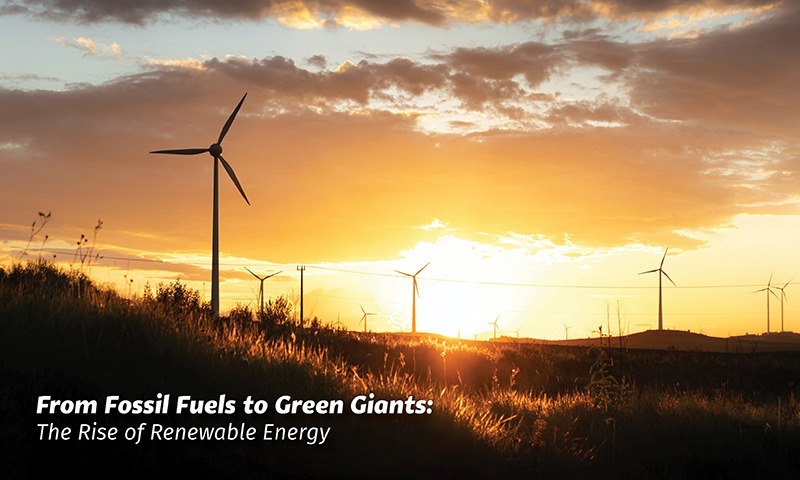In recent years, the world has witnessed a significant shift in the global energy landscape. The increasing concerns about climate change and the need for sustainable energy sources have propelled the rise of renewable energy. This article explores the journey from fossil fuels to green giants, highlighting the growth, benefits, and challenges associated with renewable energy.
The Need for Renewable Energy
As the negative impacts of fossil fuels on the environment become more apparent, the urgency to transition to cleaner alternatives has become paramount. Renewable energy sources, such as solar, wind, hydro, geothermal, and biomass, offer a sustainable and eco-friendly solution to meet our energy needs while reducing greenhouse gas emissions.
Solar Energy: Harnessing the Power of the Sun
Solar energy has emerged as one of the most promising renewable energy sources. By converting sunlight into electricity through photovoltaic cells or concentrating solar power systems, solar energy provides a reliable and abundant source of power. The declining costs of solar panels and the advancements in technology have contributed to its widespread adoption across the globe.
Wind Energy: Capturing the Breezes
Another vital player in the renewable energy sector is wind energy. Wind turbines harness the power of the wind to generate electricity. Wind farms, both onshore and offshore, have been established in various regions with favorable wind conditions. The scalability and clean nature of wind energy make it an attractive choice for governments and organizations striving to reduce their carbon footprint.
Hydropower: Tapping into Nature’s Flow
Hydropower, derived from the energy of moving water, has been utilized for centuries. Dams and turbines convert the kinetic energy of flowing water into electricity. Large-scale hydroelectric plants and small-scale run-of-river installations offer a consistent and renewable energy source. However, concerns regarding the environmental impact and displacement of local communities need to be addressed in hydropower development.
Geothermal Energy: Unleashing Earth’s Heat
Geothermal energy harnesses the heat from within the Earth to generate power. By tapping into geothermal reservoirs, steam or hot water is used to drive turbines and produce electricity. Geothermal power plants are typically located in geologically active areas with access to hot water or steam. Although geothermal energy has enormous potential, it is limited to specific regions with suitable geothermal resources.
Biomass: Utilizing Nature’s Waste
Biomass energy utilizes organic materials, such as wood pellets, agricultural waste, and dedicated energy crops, to generate heat and electricity. The combustion process releases energy and reduces the dependency on fossil fuels. Biomass offers an effective method to manage waste while producing renewable energy. However, careful consideration must be given to sustainable sourcing and the environmental impact of biomass production.
Benefits of Renewable Energy
The shift towards renewable energy brings forth numerous benefits for individuals, communities, and the planet as a whole. These include:
- Sustainability: Renewable energy sources are infinite and do not deplete natural resources.
- Reduced Emissions: Renewable energy produces minimal greenhouse gas emissions, mitigating climate change.
- Energy Independence: Relying on renewable sources decreases dependence on imported fossil fuels.
- Job Creation: The renewable energy sector offers employment opportunities and contributes to economic growth.
- Improved Air Quality: By reducing reliance on fossil fuels, renewable energy helps combat air pollution.
Challenges and Solutions
While renewable energy holds tremendous potential, several challenges hinder its widespread adoption. These challenges include:
- Intermittency: The variable nature of solar and wind power requires effective energy storage and grid management systems.
- Infrastructure: Developing the necessary infrastructure for renewable energy generation and transmission can be a complex task.
- Costs: Although renewable energy costs have significantly decreased, initial investments and maintenance expenses remain a challenge.
- Public Perception: Overcoming resistance and misconceptions about renewable energy is crucial for its acceptance.
Solutions to these challenges involve continued research and development, innovative storage technologies, policy support, and public awareness campaigns to educate and inform.
Conclusion
The rise of renewable energy marks a significant transition from fossil fuels to a more sustainable and environmentally friendly future. Solar, wind, hydropower, geothermal, and biomass energy sources offer viable alternatives that reduce greenhouse gas emissions and promote energy independence. Despite the challenges, the increasing global recognition of the need for renewable energy paves the way for a cleaner, greener, and more sustainable world.
By embracing renewable energy technologies and fostering a supportive environment, we can accelerate the shift towards a future powered by green giants.












